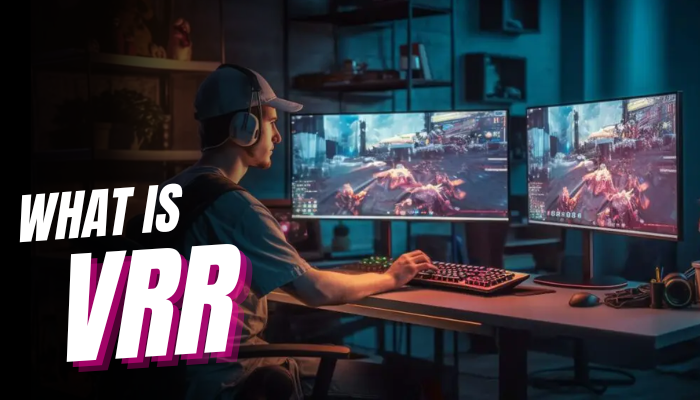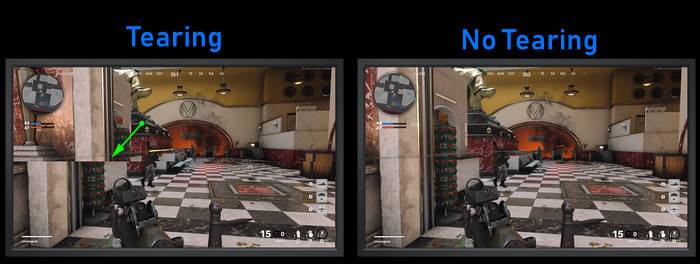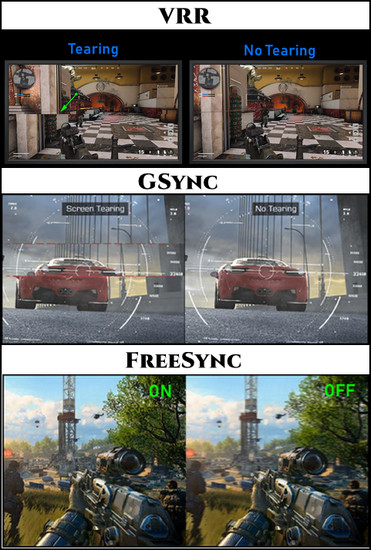If you have a high refresh rate monitor and a powerful enough GPU to produce a similarly high number of frames per second, then VRR is worthwhile.
The VRR- Variable Refresh Rate offers better sync between your game FPS and your monitor’s Refresh Rate. Though you have higher Refresh Rate monitors to adopt high Frames rates from your GPU, you’ll face screen tearing & stuttering sometimes.
Let’s get to know about VRR & how it actually works or whether you need it.
What is VRR? & How Does it Work?
VRR constantly changes the monitor’s refresh rate by matching it(refresh rate) with the FPS currently showing on the screen. In short, VRR means monitor refresh rate = FPS(Frames Per Second) in real-time.
Here is a mix-up: V-Sync does a similar thing but can not change the monitor refresh rate according to FPS. Instead, it limits & locks the Frame rate at a lower point (equal to the monitor refresh rate) to sync between monitor Hz and game FPS. Technically it is a fixed sweet point between Hertz & FPS.
Now the VRR thing. Unlike the V-Sync, it doesn’t deal with FPS; it controls the Refresh rate(Hz) instead. But it doesn’t limit the Hz at a fixed point either. It continuously fluctuates the refresh rate to match the Game’s FPS.
A proprietary example might clear every bit of doubt in this case. Imagine owning an ASUS PG65 model 65’’ monitor with a 120Hz refresh rate and playing Cyberpunk 2077 on a 4080 Ti GPU. You’ll get a Frames count of around 70FPS.
But is your monitor going to climb down to 70Hz? Even if it does, would it always match your fluctuating gaming FPS?
Here is where VRR comes in. It detects your gaming FPS and dynamically matches the refresh rate with FPS. It will always match whichever FPS your game is currently showing.
FYI the V-Sync doesn’t work this way; it requires locking at a fixed FPS(equal or half to refresh rate) to match the monitor Refresh rate. Overall the V-Sync locks gaming FPS from GPU, whereas the VRR continuously changes the monitor’s refresh rate according to FPS.
Then why would we need this VRR on our monitor?
We notice screen stuttering, tearing, and flickering when the FPS can’t match the monitor refresh rate. The VRR-enabled monitors solve this by adjusting the refresh rate(Hz) simultaneously.
It should ring the bell in your head that VRR, GSync & FreeSync are almost identical things with very few dissimilarities, discussed in a further section.
Are VRR, GSync, and FreeSync all the Same?
Modern monitors come with the GSync & FreeSync technology packed in. These are some common terminologies we hear when we buy a monitor. I call these FreeSync & GSync a wrapped-up VRR version, which isn’t entirely correct.
I said it because all of these serve the same purpose. The GSync comes with Nvidia GPUs and the FreeSync from AMD.
Though the FreeSync works with both Nvidia & AMD, the GSync is limited to Nvidia graphics cards. In fact, Gsync claims it can ultimately prevent screen tearing & stuttering, whereas FreeSync only reduces it.
It’s pretty funny we didn’t really notice any significant difference between these two technologies in our test.
But there is a difference between VRR against GSync & FreeSync, which is the LFC. The LFC stands for Low Frame Rate Compensation. And the LFC is required with FreeSync & GSync but not for VRR.
You must be thinking about LFC, how it works, why we need this, or whether it’s actually worth it. You’ll find all of these answers in a different section.
How Does the LFC Work?
The LFC stands for Low Framerate Compensation, is an add-on feature of GSync & FreeSync, and VRR sometimes because there is a specific limit between the highest and lowest refresh rate that can match gaming FPS.
Let’s say you are playing CyberPunk 2077 in 4K resolution and getting around 70-80 FPS, but the FPS can drop under 20 FPS suddenly. In that case, the minimum Hertz limit is 30 Hertz; what will happen then?
The LFC technology will double the refresh rate instead of matching the Hertz with FPS. For example, if the games climb to 20 FPS, LFC holds the frames twice as long and will double the refresh rate to 40Hz. Similarly, LFC will set 50Hz for 25 FPS, 30Hz for 15FPS, and 56Hz for 28FPS.
It will retain one frame twice as long to provide a seamless, stutter-free experience. FYI the LFC is controlled by the source, not by the monitor or screen.
FAQs
How do I know if my TV has VRR?
All monitors in the market don’t have the VRR feature; it should support VRR if your TV has a HDMI 2.1 port.
What is the VRR limit?
The lowest & highest VRR Hertz limit is 30 Hertz through 144 Hertz. The below and above refresh rate is covered with LFC.
Can an Old GPU support VRR or FreeSync?
Some old GPUs may not support VRR or FreeSync via HDMI but may support via DP(Display Port).
Does PS5 have features like GSync & FreeSync?
Yes, the PlayStations support VRR technology instead of the GSync & FreeSync.
Final Words
The VRR is a technology to provide a rich and dynamic viewing experience on the monitor. It’s a worthy feature for charm-loving gamers. As we all know, AAA-type games are meant to entertain gamers with realistic views; VRR can ensure this.
I hope you have all the information you need through this article. Please leave a comment to let us know your feedback.




